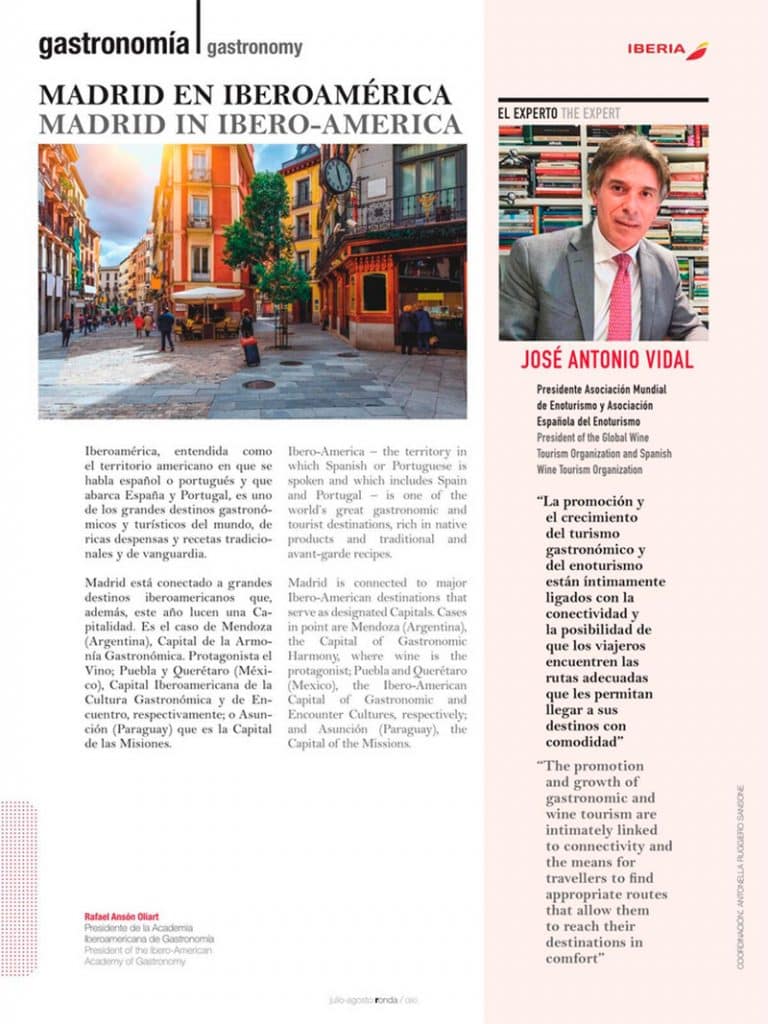ENG / ESP Press Release.
Santarém (Portugal).
The Iberian Peninsula, cradle of the Eno and Gastronomy Tourism between the Old and the New World.
The initiative arises from the Global Wine Tourism Organization GWTO as a facilitator of building international bridges in favour of positioning destinations and initiatives of high scope in the markets. Iberian Enotourism Route has the support of the Ibero-American Academy of Gastronomy AIBG for its projection in the New World, of the Spanish-Portuguese Chamber of Commerce for the coordination between companies, and of the world enotourism booking platform EnoWineClub EWC for marketing the experiences.
“AIBG always had a special interest in highlighting the contribution of the Iberian Peninsula in everything related to wine as a fundamental food to complete the gastronomic offer of Ibero-America. There is nothing better than tourism among the rivers and landscapes of both countries to enjoy their gastronomic cultural essence,” said Rafael Ansón, Founding President of AIBG and Founding Honorary President of the International Academy of Gastronomy.
“The project is a clear example of the twinning between two countries through their Spanish (AEE) and the Portuguese (APENO) EnoTourism Associations. Two countries united to boost and emphasize the great richness of their cultural heritage, their history, their art and their wine and gastronomy tradition”, said José Antonio Vidal, Founder President CEO of the Spanish Enotourism Association (AEE) and Global Wine Tourism Organization (GWTO).
“Entrepreneurs and public sector actors are required to be supportive among ourselves and with the community, collaborating with actions that contribute both to the socio-economical development of the destinations and their residents as well as to the consumers satisfaction”, stated the president.
The tourism product will be designed by an international team of Spanish-Portuguese tour operators to be promoted and commercialized in global markets.
“The entire Spanish-Portuguese border (La Raya-A Raia), with its 17 provinces from the stuary of the Miño-Minho River down to that of the Guadiana River, features the tourism resources necessary for the creation of quality offerings around the ‘Longest EnoTourism Route between two countries within the European Union’ with more than 1.215 kms,” concluded Vidal.
Ruta Ibérica del Enoturismo
La Península Ibérica, cuna del turismo eno-gastronómico entre el Viejo y el Nuevo Mundo
Nota de Prensa
Santarém (Portugal)
La iniciativa surge de la Organización Mundial del Enoturismo OMET como facilitadora de puentes internacionales a favor de posicionar en los mercados destinos e iniciativas de alto alcance.La Ruta Ibérica cuenta con los apoyos de la Academia Iberoamericana de Gastronomía AIBG para su proyección en el Nuevo Mundo, de la Cámara de Comercio Hispano-Lusa para la coordinación entre empresas, y de la plataforma de reservas del enoturismo mundial EnoWineClub EWC para la comercialización de las actividades.
“AIBG siempre ha tenido especial interés en destacar la aportación de la Península Ibérica en todo lo que se refiere al vino como alimento fundamental para completar la oferta gastronómica de Iberoamérica. Nada mejor que el turismo entre sus ríos y paisajes de ambos países para disfrutar de su esencia cultural gastronómica”, indica Rafael Ansón, Fundador Presidente de AIBG y Fundador Presidente de Honor de la Academia Internacional de Gastronomía.
“El proyecto binacional es un claro ejemplo del hermanamiento de los dos países a través de sus Asociaciones Española (AEE) y Portuguesa (APENO) de Enoturismo. Dos países que comparten geografía y hospitalidad, y que ahora se unen para potenciar y destacar conjuntamente su gran riqueza patrimonial, Historia, Arte y eno-gastronomía”, señala José Antonio Vidal, Fundador Presidente CEO de la Asociación Española de Enoturismo (AEE) y de la Organización Mundial del EnoTurismo (OMET).
“Los empresarios y los actores del sector público estamos obligados a ser solidarios entre nosotros y con la comunidad, cooperando en acciones que aporten desarrollo socio-económico a los destinos y sus residentes, así como satisfacción a los consumidores”, afirma el presidente.
El producto turístico será diseñado por un equipo internacional de turoperadores hispano-luso y comercializado en mercados globales.
“Toda la frontera hispano-lusa (La Raya-A Raia) con sus 17 provincias desde la desembocadura del río Miño-Minho hasta la del río Guadiana, cuenta con todos los recursos turísticos necesarios para la creación de oferta de calidad en torno a la ‘Ruta del Vino más Larga entre dos países de la Unión Europea’, con más de 1.215 kms”, constata Vidal.


